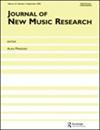Concordia: A musical XR instrument for playing the solar system
IF 1.1
4区 计算机科学
Q4 COMPUTER SCIENCE, INTERDISCIPLINARY APPLICATIONS
引用次数: 2
Abstract
ABSTRACT Kepler Concordia, a new scientific and musical instrument enabling players to explore the solar system and other data within immersive extended-reality (XR) platforms, is being designed by a diverse team of musicians, artists, scientists and engineers using audio-first principles. The core instrument modules will be launched in 2019 for the 400th anniversary of Johannes Kepler's Harmonies of the World, in which he laid out a framework for the harmony of geometric form as well as the three laws of planetary motion. Kepler's own experimental process can be understood as audio-first because he employed his understanding of Western Classical music theory to investigate and discover the heliocentric, elliptical behaviour of planetary orbits. Indeed, principles of harmonic motion govern much of our physical world and show up at all scales in mathematics and physics. Few physical systems, however, offer such rich harmonic complexity and beauty as our own solar system. Concordia is a musical instrument that is modular, extensible and designed to allow players to generate and explore transparent sonifications of planetary movements rooted in the musical and mathematical concepts of Johannes Kepler as well as researchers who have extended Kepler's work, such as Hartmut Warm. Its primary function is to emphasise the auditory experience by encouraging musical explorations using sonification of geometric and relational information of scientifically accurate planetary ephemeris and astrodynamics. Concordia highlights harmonic relationships of the solar system through interactive sonic immersion. This article explains how we prioritise data sonification and then add visualisations and gamification to create a new type of experience and creative distributed-ledger powered ecosystem. Kepler Concordia facilitates the perception of music while presenting the celestial harmonies through multiple senses, with an emphasis on hearing, so that, as Kepler wrote, ‘the mind can seize upon the patterns’.Concordia:一种用于演奏太阳系的XR乐器
摘要开普勒Concordia是一种新的科学和乐器,使玩家能够在沉浸式扩展现实(XR)平台内探索太阳系和其他数据,由音乐家、艺术家、科学家和工程师组成的多元化团队使用音频优先原则设计。核心仪器模块将于2019年推出,以纪念约翰内斯·开普勒的《世界和谐》400周年,他在该书中阐述了几何形状和谐以及行星运动三定律的框架。开普勒自己的实验过程可以首先被理解为音频,因为他利用对西方古典音乐理论的理解来研究和发现行星轨道的日心椭圆行为。事实上,谐波运动的原理支配着我们的大部分物理世界,并在数学和物理学的各个层面上都有所体现。然而,很少有物理系统能像我们自己的太阳系那样提供如此丰富的谐波复杂性和美感。Concordia是一种模块化、可扩展的乐器,旨在让玩家生成和探索行星运动的透明声音,这些声音植根于约翰内斯·开普勒的音乐和数学概念,以及扩展开普勒工作的研究人员,如Hartmut Warm。它的主要功能是通过对科学准确的行星星历和天体动力学的几何和关系信息进行声波处理,鼓励音乐探索,从而强调听觉体验。Concordia通过互动式声波浸入来强调太阳系的和谐关系。本文解释了我们如何优先考虑数据声波化,然后添加可视化和游戏化,以创建一种新型的体验和创造性的分布式账本驱动生态系统。开普勒Concordia促进了对音乐的感知,同时通过多种感官呈现天籁之音,重点是听觉,因此,正如开普勒所写,“大脑可以抓住这些模式”。
本文章由计算机程序翻译,如有差异,请以英文原文为准。
求助全文
约1分钟内获得全文
求助全文
来源期刊

Journal of New Music Research
工程技术-计算机:跨学科应用
CiteScore
3.20
自引率
0.00%
发文量
5
审稿时长
>12 weeks
期刊介绍:
The Journal of New Music Research (JNMR) publishes material which increases our understanding of music and musical processes by systematic, scientific and technological means. Research published in the journal is innovative, empirically grounded and often, but not exclusively, uses quantitative methods. Articles are both musically relevant and scientifically rigorous, giving full technical details. No bounds are placed on the music or musical behaviours at issue: popular music, music of diverse cultures and the canon of western classical music are all within the Journal’s scope. Articles deal with theory, analysis, composition, performance, uses of music, instruments and other music technologies. The Journal was founded in 1972 with the original title Interface to reflect its interdisciplinary nature, drawing on musicology (including music theory), computer science, psychology, acoustics, philosophy, and other disciplines.
 求助内容:
求助内容: 应助结果提醒方式:
应助结果提醒方式:


